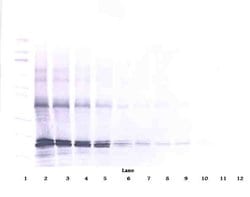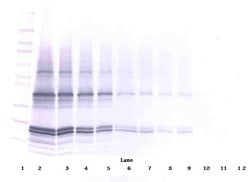Learn More
PeproTech p16INK4a-TAT Polyclonal Antibody, Biotin, PeproTech®, Invitrogen™
Rabbit Polyclonal Antibody
Supplier: PeproTech 500P284TBT50UG

Description
AA Sequence of recombinant protein: EPAAGSSMEP SADWLATAAA RGRVEEVRAL LEAGALPNAP NSYGRRPIQV MMMGSARVAE LLLLHGAEPN CADPATLTRP VHDAAREGFL DTLVVLHRAG ARLDVRDAWG RLPVDLAEEL GHRDVARYLR AAAGGTRGSN HARIDAAEGP SDIPDGYGR KKRRQRRR. Preparation: Produced from sera of rabbits immunized with highly pure Recombinant Human p16-INK4a-TAT. Anti-Human p16-INK4a-TAT-specific antibody was purified by affinity chromatography and then biotinylated. Sandwich ELISA: To detect Human p16-INK4a-TAT by sandwich ELISA (using 100 μL/well), a concentration of 0.25-1.0 μg/mL of this antibody is required. This biotinylated polyclonal antibody,in conjunction with PeproTech Polyclonal Anti-Human p16-INK4a-TAT (500-P284) as a capture antibody, allows the detection of at least 0.2-0.4 ng/well of Recombinant Human p16-INK4a-TAT. Western Blot: To detect Human p16-INK4a-TAT by Western Blot analysis, this antibody can be used at a concentration of 0.1-0.2 μg/mL.When used in conjunction with compatible development reagents, the detection limit for Recombinant Human p16-INK4a-TAT is 1.5-3.0 ng/lane, under either reducing or non-reducing conditions. 500-P284TBT-1MG will be provided as 2 x 500 μg
p16-INK4a is a nuclear protein that regulates the cell cycle by inhibiting cyclin-dependent kinase-4 (CDK4) and CDK6. p16-INK4a inhibits CDK activity by binding to the CDK molecules in a manner that interferes with their ability to interact with cyclin D. This activity has the effect of suppressing tumor formation and growth, and of inducing replicative senescence in various normal cells, including stem cells. The expression of p16-INK4a steadily increases with age, and tends to accumulate in stem cell compartments. The deletion, rearrangement, or mutation of the p16-INK4a gene is frequently found in melanomas, as well as in certain other types of cancer. p16-INK4a and other transcription factors have been introduced into cells by DNA transfection, viral infection, or microinjection. Protein transduction using TAT fusion proteins represents an alternative methodology for introducing transcription factors and other nuclear proteins into primary, as well as transformed, cells.
Specifications
| p16INK4a-TAT | |
| Polyclonal | |
| Biotin | |
| CDKN2A | |
| p16INK4a | |
| Rabbit | |
| Antigen affinity chromatography | |
| RUO | |
| 1029 | |
| -20°C | |
| Lyophilized |
| ELISA, Western Blot | |
| 0.1-1.0 mg/mL | |
| PBS with no preservative | |
| P42771, Q8N726 | |
| CDKN2A | |
| E.coli-derived, 18.0 kDa Recombinant Human p16-INK4a-TAT. | |
| 50 μg | |
| Primary | |
| Human | |
| Antibody |
The Fisher Scientific Encompass Program offers items which are not part of our distribution portfolio. These products typically do not have pictures or detailed descriptions. However, we are committed to improving your shopping experience. Please use the form below to provide feedback related to the content on this product.


